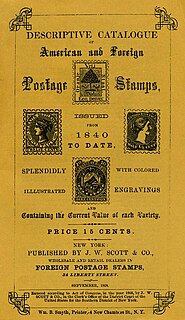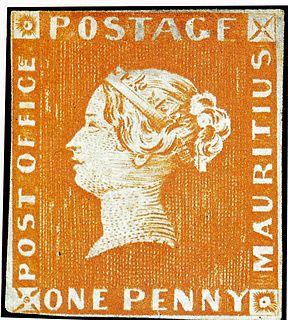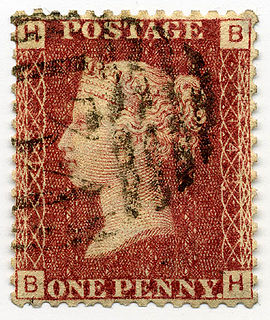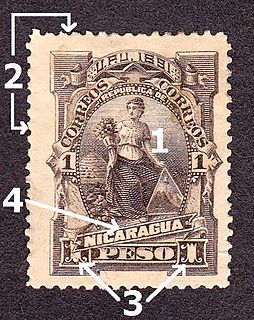
Stamp collecting is the collecting of postage stamps and related objects. It is related to philately, which is the study of stamps. It has been one of the world's most popular hobbies since the late nineteenth century with the rapid growth of the postal service, as a never-ending stream of new stamps was produced by countries that sought to advertise their distinctiveness through their stamps.

Philatelic literature is written material relating to philately, primarily information about postage stamps and postal history.

The Scott Catalogue of postage stamps, published by Scott Publishing Co, a subsidiary of Amos Media, is updated annually and lists all the stamps of the entire world which its editors recognize as issued for postal purposes. It is published in eight large volumes that include six volumes containing all the countries of the world that have ever issued postage stamps, the United States Specialized Catalog, and the 1840-1940 Classic Specialized Catalogue. It is also produced in non-printable CD and DVD editions. The numbering system used by Scott to identify stamps is dominant among stamp collectors in the United States, Canada and Mexico.

A piece of postal stationery is a stationery item, such as a stamped envelope, letter sheet, postal card, lettercard, aerogram or wrapper, with an imprinted stamp or inscription indicating that a specific rate of postage or related service has been prepaid. It does not, however, include any postcard without a pre-printed stamp.

The 2¢ Large Queen on laid paper is the rarest postage stamp of Canada. Printed in 1868, it was not discovered until 1925, and so far only three have been found, all used. Many more could exist as at least one sheet must have been printed, and possibly many sheets; however, they may all have been destroyed, or lie unrecognised in stamp collections or on cover.

The Mauritius "Post Office" stamps were issued by the British Colony Mauritius in September 1847, in two denominations: an orange-red one penny (1d) and a deep blue two pence (2d). Their name comes from the wording on the stamps reading "Post Office", which was soon changed in the next issue to "Post Paid". They are among the rarest postage stamps in the world.

Lawrence Lewis "Larry" Shenfield was an advertising executive who was instrumental in promoting the development of radio broadcasting during its golden age of the 1920s and 1930s. Larry lined up sponsors to help further the popularity of such stars as Orson Welles and Dinah Shore. After his retirement, Larry developed a second career as a prominent philatelist internationally recognized in the field of postal history. His careful studies of the postage stamps and postal history of the Confederate States are relied upon by stamp collectors and experts in philately to the present day.
Bertram McGowan (1874–1950) was a Scottish solicitor and philatelist who specialised in Chile and the Postage stamps and postal history of Great Britain, especially Great Britain used abroad.
The Stamp Specialist is the title of a series of books on philatelic research written and edited for the advanced collector of postage stamps.
August Dietz was a philatelist, editor and publisher, who specialized in the study of mail and postal history of the Confederate States of America.
Philip Henry Ward Jr., of Philadelphia, Pennsylvania, was a stamp dealer who created and sold collections of rare postage stamps, and was noted for his stressing the importance of first day covers of United States stamps.
Edward Boker Sterling , of Trenton, New Jersey, was a philatelist who specialized in the study of United States postage stamps, postal stationery, and revenue stamps.
Raymond Henry Weill, of New Orleans, Louisiana, and his brother Roger G. Weill, were famous dealers of rare postage stamps, commonly referred to as the Weill brothers.
Charles James Phillips of London, England, and New York City, was a philatelist highly regarded in both England where he started his philatelic career and in the United States, where he emigrated to in 1922.
The Confederate Stamp Alliance is a philatelic organization dedicated to the collection and study of postage stamps and postal history of the Confederate States of America (CSA). It is an affiliate of the American Philatelic Society.
Walter Stone Scott, of New York City, was an auctioneer of postage stamps and postal history items. He was the son of the famous philatelist John Walter Scott.
William Hogarth Tower (1871–1950), of New Jersey, USA was a postage stamp collector who endowed a "stamp room" at Princeton University.
Carl Einar Pelander was a stamp dealer and auctioneer who was an expert on postage stamps and postal history of the Scandinavian countries of Denmark, Greenland, Iceland, Danish West Indies, Finland, Norway, and Sweden.

Benjamin Wishnietsky (1915-2013) was a retired textile chemist and a collector of United States, Greek, and Confederate philatelic material for his entire adult life.

The Ferrer block is a corner block of 15 of the 80 centésimos green 1856 'Diligencia' (Suns) postage stamps, and is regarded by many philatelists as the most important item of Uruguayan philately. Fred Melville, speaking philatelically, called it "one of the seven wonders of the world". It is the largest known multiple of this issue of which only a few blocks are known to exist. Most of the plating information about this issue has been derived from this one block.















